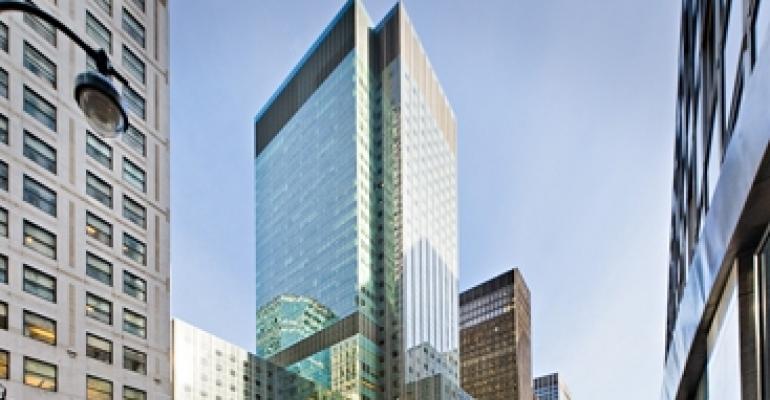
Madison International Realty doesn’t buy real estate, but it has more than $1 billion invested in commercial properties around the globe.
Ronald Dickerman, president of the New York-based real estate investment firm, describes his company’s role in the bulk of its deals as being a “secondary buyer and substitute equity provider.” Essentially, the company buys pieces of existing ownership structures when an asset’s investors need an exit strategy, or investors may bring Madison in as a new equity partner.
And there are plenty of commercial real estate owners looking for equity partners like Madison to help de-lever their properties, due to declining asset values that make it difficult to replace mortgages with new financing at maturity. Commercial asset values in the United States in October had fallen 45% from the market peak in October 2007, according to the most recent snapshot from the Moody’s/REAL Commercial Property Price Indices.
“We’ve never been busier,” says Dickerman, who founded Madison 14 years ago. “Since Labor Day we’ve seen a major increase in transactions submitted to our shop.”
Investing in Chrysler tower
A recent transaction provides a good example of the way Madison works. Earlier this month, the company announced that it had established a 48.9% ownership interest in the Chrysler East Building, a 32-story office tower next to the Chrysler Building in New York City. But it didn’t acquire that interest in a single transaction.
Madison bought out a German investor to gain its first limited-partnership interest in the Chrysler East Building in March 2008. A group of individual German investors had acquired 80% of the 745,000 sq. ft. asset in a joint venture with Tishman Speyer Properties in 2002.
The global credit crisis was at a fever pitch in 2008, and Madison had learned through its office in Frankfurt, Germany, that some of the German investors in the Chrysler East Building were looking for a way to liquidate their interest rather than ride out the full 10 years they had signed on for when they entered Tishman Speyer’s joint venture in 2002. Enter Madison, with a standing offer to buy out individuals looking for an early exit from the deal, and a string of buyouts followed.
In an unrelated deal, Madison is working with a developer that owns a portfolio of grocery-anchored shopping centers. The properties are stabilized, but the developer has been unable to roll its construction loans over into long-term debt financing due to a $65 million gap between available loan proceeds and the outstanding balance of maturing debt on the properties.
Madison is negotiating to provide additional equity that will help the developer and its existing investors bridge the equity gap and pay off the construction loans with long-term financing. For Madison, the arrangement would provide interest in a stabilized portfolio of shopping centers with a weighted average lease term of 16 years.
Only the best
Madison restricts its dealings to core real estate assets, and owns interests in some of the most valuable buildings on the planet. Those include a 17.5% interest in Devonshire House, a trophy office building overlooking Green Park and Buckingham Palace in London. Other Madison investments include interests in 520 Madison Avenue and the Seagram Building at 375 Park Avenue, both in New York, as well as trophy assets and portfolios in other states and overseas.
And while Madison may provide capital to help property owners qualify for a new mortgage on a trophy asset, the company isn’t interested in properties that require repositioning or a new leasing strategy. “We’re looking to fix broken balance sheets through equity infusions, as compared to investing in broken assets,” says Dickerman.
Relative to the volume of capital raised for distress investment, there aren’t many examples of third-parties coming in to de-lever commercial properties in order to help the owner qualify for a new loan, according to Sam Chandan, chief economist at New York-based researcher Real Capital Analytics. Opportunities for that kind of transaction abound, however, and are growing.
Strict underwriting, such as loan-to-value ratios of 60% to 65% on new loans, coupled with an overall decline in real estate values nationwide have prevented thousands of property owners from obtaining financing they need to replace maturing loans. The pool of unresolved distress among commercial real estate borrowers has grown to nearly $200 billion in the United States alone, says Chandan, and that volume will increase in 2011 as aggressively underwritten loans from the market’s peak approach maturity.
“The opportunity to put new capital to work in the de-leveraging process will increase as we move forward in addressing maturities,” says Chandan. “There are high-quality core properties that are over-leveraged, where the distress is related to the performance of the debt, that will prove attractive to investors.”
Equity investors seeking those deals will have to find them on their own, it seems, because Madison has raised roughly $500 million in its current fund and isn’t seeking additional investors. With some 39 employees at its New York headquarters and offices in London and Frankfurt, the company has its collective ears to the ground in search of opportunities.
What it isn’t seeking, according to Dickerman, are targets for hostile buyouts or takeovers. Madison isn’t a real estate manager, he reiterates, and seeks only partial ownership interests in healthy, valuable properties. “We want to invest as a validation of an owner’s business plan,” says Dickerman, “as opposed to changing the business plan, picking a fight or kicking them out.”

